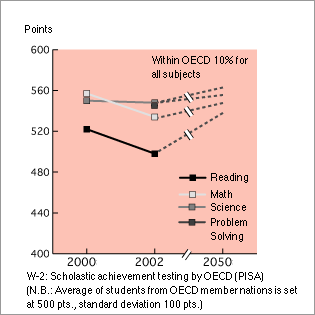ProjectsPast and current JFS projects
Indicators - Wellbeing / Academic Performance and Education
W-2. Academic achievement measured by PISA
(PISA: Programme for International Student Assessment. Administered by OECD*)
*Organization for Economic Cooperations and Development 1.Current Values
Reading ability 498 points (in OECD top 20%)
Mathematical literacy 534 points (in top10%)
Scientific literacy 548 points (in top 10%)
Problem Solving Knowledge and Skills (in top10%) (2003)
2.Current Points
(out of a perfect score of 100 by 2050) 93 points
Calculation method:
For each subject, 100 points was awarded if in the top 10%, 80 points if in the top 20%, 60 points if in the top 30%, 40 points if in the top 40%, 20 points if in the top 50%, and zero points are awarded if below the average. The score is the average for each subject.
3. Explanation of Indicator
It is people who create a sustainable society, and it is people who shine within it. In order to respond from this time forward to the reforms in social systems that are being demanded, one must go beyond learning a specific curriculum; it is necessary to be able to take the acquired knowledge and thinking processes and apply them to a variety of situations.
JFS has adopted as an indicator the PISA of OECD, an international survey that measures scholastic achievement from the three aspects of reading literacy, mathematical literacy, and scientific literacy. This indicator measures to what extent children can apply to the various challenges of real life the essential knowledge and skills for living in the future,
4.Target for 2050
Within top 10% in all fields of the OECD.
5.Ideal for the Future
Within the top 10% in all fields of the OECD.
6. Rationale for Ideal and Target Values
Normally it is desirable to assess scholastic ability not by comparison with others but by assessing individual abilities in absolute terms. It is particularly meaningless to feel elation or despair as a result from being ranked comparatively above or below other nations, for reasons including significant statistical differences.
However, we think it is necessary to spend more time for learning and demonstrate the skills for applying knowledge to the challenges to be confronted in the world today. In this sense it can be said that it is desirable to be at a level that can lead the world. With this in mind, we have set as our ideal and target values to be within the top 10% of the nations of the OECD, which in particular share similar levels of economic development.
7. Source
National Institute for Educational Policy Research "Academic Achievement Survey of OECD Students"
Related information:
OECD "Programme for International Student Assessment (PISA)"
8. Notes
Tests were predominantly for reading literacy in 2000, mathematical literacy in 2003, and scientific literacy in 2006 as the core domains. In 2003 testing included problem solving knowledge and skills in these 3 fields as well. [The testing] is implemented every 3 years, and 276,000 people from 41 countries and regions participated in 2003.



